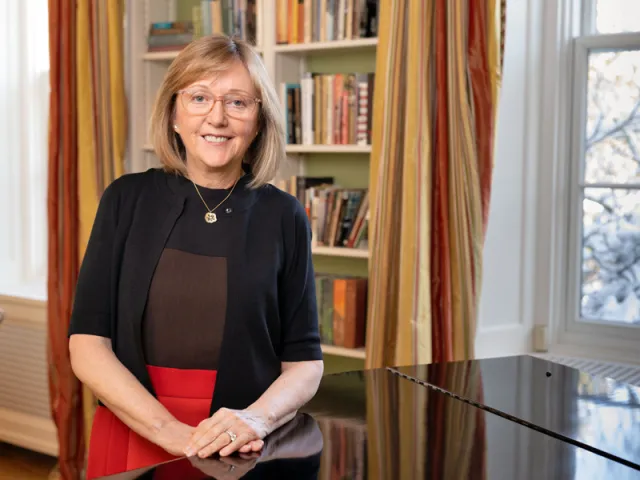A Bold Investment in Financial Aid
Smith Quarterly
How did the decision to eliminate loans come to be? President McCartney offers a behind-the-scenes look at one of the most consequential decisions of her tenure.

Published March 31, 2022
Friday, October 22, 2021, marked a monumental moment in Smith College’s history. That is the day that Smith’s board of trustees wholeheartedly endorsed the elimination of loans from the college’s financial aid packages. As a board and a leadership team, we knew what we were doing was going to change lives—and it already is.
Immediately following our announcement, students and alums responded with gratitude and pride. A student wrote, “I wanted to thank you for giving us grants rather than loans next year. I really appreciate this and it means so much to me, my family, and for my future self.” An alum wrote, “I have never been more proud of Smith College. Having received financial aid as a student, this move really touches my heart.” Another alum observed simply, “This is profound equity work.”
Media response to our news was immediate and powerful. The story was covered by the Associated Press, The Boston Globe, Marketplace, The Washington Post, and media around the world. I was delighted to give interviews—to shout the news from the rooftops, in fact. At Smith, we want every qualified applicant, from every walk of life, to know that Smith is a possibility.
The decision to eliminate loans emerged from a collaborative process among college leadership and trustees. Board of Trustees Chair Alison Overseth ’80 and I led a working group charged with recommending how Smith could deploy student aid most effectively in service of its access mission. Eliminating loans emerged as a compelling way to relieve a major financial burden for students and families and to level the playing field for post-college success. We are able to make this $7 million annual investment in our students because of strong endowment returns over the past decade and with the generous support of our alums and donors.
Eliminating loans benefits every student receiving aid but especially students of color. Black and Latino/a students across the country disproportionately take on education debt. The National Center for Education Statistics reports that Black college graduates owe an average of $25,000 more in student loan debt than white college graduates. At Smith, 89 percent of Black students graduate with loans, compared with 56 percent of white students. Eliminating loans is a consequential step Smith is taking toward racial justice.
Leaving school without debt equalizes the post-graduate experience, opening career possibilities across the earnings spectrum. The need to repay college loans may prevent students from considering graduate study because they feel pressure to immediately generate income. When contacted by The Washington Post about Smith’s elimination of loans, first-year student Livie Johnston, who plans to major in English and pursue graduate study in library science, expressed gratitude for the freedom that minimal debt will afford her: “I’m completely covered by Smith’s financial aid for the next three years of my education here, which makes a really big difference for the affordability of grad school,” she said. “This really takes a lot of the stress off.”
On January 15, we concluded the application season for the class of 2026, which saw the largest number of applications—7,264—in Smith history. That figure represents a 20% increase over last year and an astonishing 63% increase in just eight years. Moreover, we received the most applications ever from first-generation college students and students of color. While it is too soon to know the precise impact of our no-loans initiative on students’ decisions to apply, early evidence suggests that our bold commitment to equity is resonating.
Equity is at the heart of Smith’s mission, a mission that resonates profoundly with me. I was the first in my family to attend college; I owe my college education—and the doors it opened across my lifetime—to generous financial aid. Expanding education access at Smith has been my top priority.
Back in October, when we announced our no-loans initiative, only about 20 colleges had that status. And Smith was the first women’s college to join that group. Toward the end of one media interview, a reporter asked me if I was worried that Smith’s competitors would follow our lead. My response? “I hope they will.”

FINANCIAL HEALTH
‘A More Appealing Education for All’
How might the new policy impact student decisions before and after college? An economics professor weighs in.
EQUITY OF OPPORTUNITY
‘Smith Is Decreasing Barriers to Entry’
If education has the potential to be transformational, shouldn’t it be accessible to all? A sociologist says yes.

DREAMS WITHIN REACH
‘How Will You Ever Afford to...?’
And other questions an education professor anticipates hearing less of now that loans will no longer deter students from pursuing a career like teaching.
This story appears in the Spring 2022 issue of the Smith Alumnae Quarterly.
Illustrations by Fernando Cobelo

